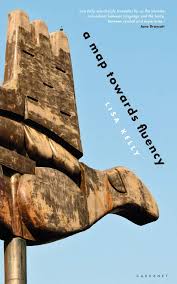A Map Towards Fluency
Lisa Kelly
(Carcanet, 2019); pbk £9.99
While A Map Towards Fluency might be Kelly’s first poetry collection, it shows an impressive imagination and originality. The poet is both partly deaf and partly Danish, though entirely unable to understand her mother’s native tongue, and she has incorporated both of these aspects of her life into her poetry, which focuses on the power of words and the idea of fluency.
As a Dane myself, I am particularly fascinated with her use of my mother tongue. A Map Towards Fluency includes everything from Danish insults ‘Se, en anden giraf!’ (look at that giraffe!) to declarations of love ‘Jeg elsker dig.’ (I love you). Kelly’s fascination with the Danish language can be observed in the poem ‘Ø’, despite it only incorporating a single Danish word. In ‘Ø’, Kelly talks about her yearning to be able to speak her mother’s native tongue.
I dream of Ø, wishing
it in my blood
as the English sound
that comes so easily, it is thoughtless [.]
The poem also dwells upon Kelly’s difficulties with the pronunciation of the Danish language. It is an emotionally charged poem, full of frustration and dissatisfaction.
Surrounded by a sea of white
Ø is what it means
but I can’t possess
even this small word [.]
Besides her use of the Danish language, Kelly incorporates Danish culture into her poetry, which ranges from a reference to Danish art in the poem ‘Life Model’ to geography and superstition in ‘Six Perspectives on Lilian Kjærulff’, where the narrator is told that ‘13 was a lucky number in Denmark.’ Thirteen is, by the way, considered the absolute opposite of a lucky number in Denmark – just as it is in most of the Western World.
Kelly’s aforementioned partial deafness is likewise an important aspect of her poetry, and her fascination with sign language – a language to be seen rather than heard – results not only in poems with a focus on deafness but additionally with a structure built upon being seen rather than heard. This is perhaps most clearly shown in the title poem ‘A Map Towards Fluency’, where Kelly has made various unconventional structural choices, one of which is her use of spaces for visual effect.
Words are shifting animals
a fish is a handshimmer
a cat is claws, preening whiskers a bird, a forefinger breaking a thumb[.]
In the same poem, we find a structure focused on the physical shape – or body – of one of the subsequent stanzas. Kelly’s use of the pyramid shape is particularly interesting, as the subject of the stanza is her old teacher. It is not uncommon to utilise the pyramid structure while teaching, as it can help make poetry more approachable. It is also a valuable tool in teaching children about language, and one has to wonder if Kelly’s choice of the pyramid is caused by nostalgic memories accompanying the shape.
Jean
Our teacher
is a landmark
All eyes look to her
What can you see out of your
Peripheral vision? Furrows forming
and reforming on ever-more familiar faces[.]
While many poems in her collection are divided up into more conventionally symmetrical stanzas, Kelly does not shy away from more unusual structures. She generously utilizes footnotes, symbols, and columns to create a unique poetic structure, and one poem ‘Philip Levine´s Good Ear’ has quite literally been turned 90 degrees in her quest for the desired visual effect. Kelly’s use of shape to make socio-political points is reminiscent of the prose-poetry in Microbursts by Elizabeth Reeder, in which she makes use of compacted typescript to simulate a torrent of emotion.
A Map Towards Fluency is an experimentation of the written language and a must-read for anyone interested in the amalgamation of the audible and the visual. In the poet’s own words: ‘How can form not matter?’
Maria Sjöstrand


[…] March 3, 2021 / lisakellypoet A Map Towards Fluency […]